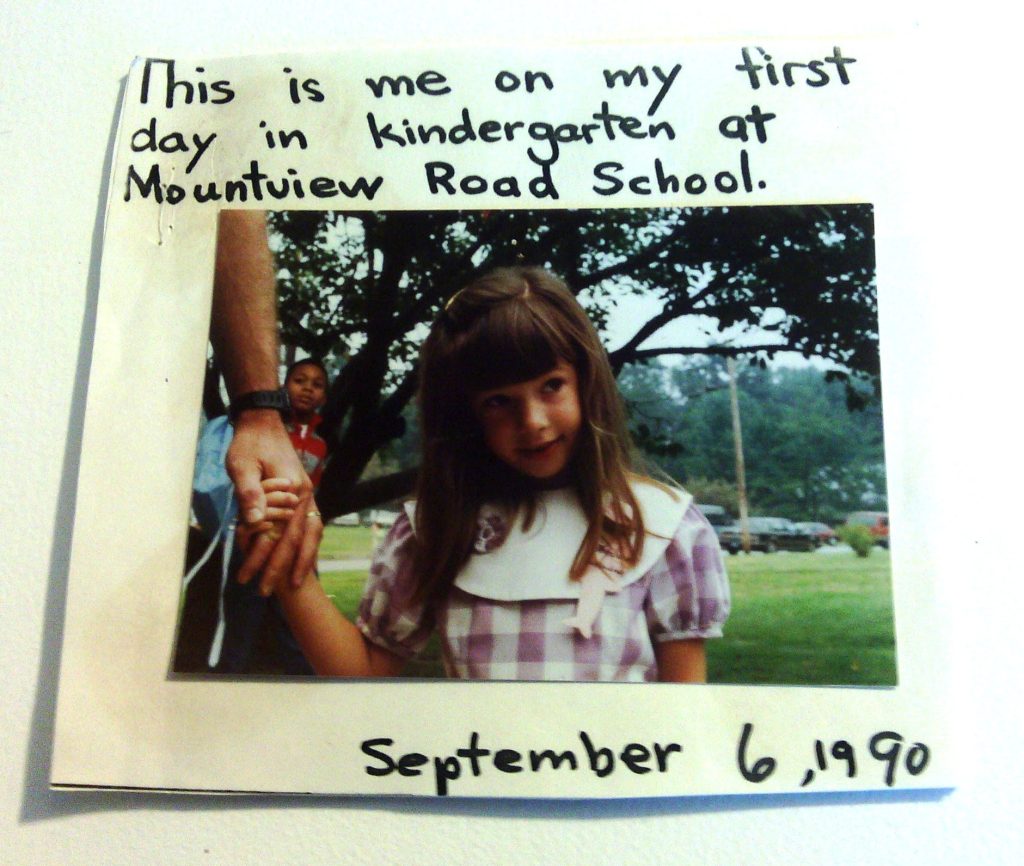I had my first anxiety attack in the first grade, when the teacher returned my paper with See Me written in red ink instead of the usual Excellent. That perceived failure felt so devastating, I almost couldn’t breathe.
What causes perfectionism in a child that young? What makes a six year old to get that stressed out?

What causes perfectionism?
The root cause of perfectionism is very simple: it’s fear. Perfectionism arises because when we were small, we didn’t feel protected or loved unconditionally. At some point early on, we learned to be afraid.
At its core, perfectionism is just fancied-up fear. As Elizabeth Gilbert writes in Big Magic:
…perfectionism is just fear in fancy shoes and a mink coat, pretending to be elegant when actually it’s just terrified. Because underneath that shiny veneer, perfectionism is nothing more that a deep existential angst the says, again and again, ‘I am not good enough and I will never be good enough.
Where does this fear come from? How do we get to this place of believing that we’re not good enough, and we never will be? As Martha Beck tells us in The Way of Integrity, most of our psychological pain arises from the twin forces of trauma and socialization.
Trauma is anything that’s shocking and upsetting enough to exceed our capacity to cope with it. If we don’t learn how to heal our traumas and resolve emotional-level wounds, we stay afraid and in pain. Fear becomes our baseline, always running in the background.
Socialization is how we’re taught to be by the people around us. If we don’t learn to decide for ourselves what’s true, we end up living by a fear-based list of dos and don’ts in an attempt to avoid abandonment.
It sounds like this: “Be a good girl, be nice, don’t get mad…” with the implied rest of the sentence being, “…or else no one will love you.”
That’s how the problem starts. But how do we heal it?
To heal the fear that underlies perfectionism, we must learn to apply love to the parts of ourselves that are hurting and scared.
Long-term fear is an emotional-level issue, and as such, we need to do emotional-level work in order to resolve it. The trouble is, almost none of us learned to do emotional-level work growing up! Most of us only learned how to do physical and mental work.
But before I give you an emotional-level tool to practice, let me tell you a story of how my old childhood friend perfectionism showed up for me as an adult.
What motivates perfectionism?
“I love Daddy infinity, and Mommy, I love you nine hundred.”
The first time our five year old dropped this bombshell at bedtime, I kept my composure with her, then panicked in private.
(Perhaps you’re good at this, too…keeping up a brave face in a tough moment, only letting yourself fall apart later, when you’re alone? Do you always look like you’re fine, even if you’re not?)
Turns out, parental favoritism is normal and developmentally appropriate. It’s part and parcel of being five years old, especially when your 3-year-old sister has a preference for mommy. Before I knew this, though, I had some questions.
Had I failed my kid? Did she not trust me? Did she have a sense for how far apart nine hundred and infinity actually are? (No, no, and no.) Yet for a moment I was tempted to focus all my energy on trying to be “better” so she would love me infinity, too!
It got me thinking about our endless quest for approval, and the ways in which we twist ourselves into pretzels trying to be perfect so we can be loved.
We give beyond our limits, trying to be someone’s “infinity.” Then we get so depleted, because while our love is infinite, our bodies are not.
The standard advice says to say no, slow down, and practice self-care. It’s not bad advice, but it’s incomplete. And most people I’ve coached have had a tough time following it.
You see, the usual guidance doesn’t address what motivates perfectionism. The central lie that drives perfectionistic behavior is: I don’t have value unless someone else says I do.
If we don’t address that lie, we’re probably going to feel WORSE when we slow down and do less. We’ll feel more anxious, depressed, and ashamed – because we’re not getting our “hits” of approval anymore.
From there, we’ll either …
a) double down on our old pattern of doing too much for others, while feeling guilty for having stopped in the first place, or…
b) self-medicate with substances or compulsive behaviors.
But if the standard advice doesn’t work, what does? Plugging into a different power source.
Here’s what I mean. Approval-seeking and perfectionistic behavior is based in fear. It’s an emotional-level issue; it’s a part that’s desperate to be healed.
The desperation sounds like this: “See me. Value me. Honor me.”
We’re waiting for someone else to do it. But that’s a trap! How can we expect others to do it, when we don’t? This was where I got stuck with my kid. I was expecting her to value my whole journey through parenthood, and *I* hadn’t really done it!
Perhaps you can relate to this? Ever noticed how you can recognize something unsettling – say, how you’ve been chronically exhausted for years, or sacrificing too much to “win” someone’s approval – and then, quick as a wink, you file that uncomfortable truth far away?
This is called denial, and if you had a tough childhood, you’re probably good at it. You had to be. To survive, you needed to get good at putting certain truths off to the side.
But a big part of recovery from perfectionism is letting yourself know what’s real, and how you really feel about it. (Even when it’s painful, the truth is medicine.)
How to overcome perfectionism starting now
Here’s one practical, accessible way to do this, excerpted from my book, You Don’t Owe Anyone: Free Yourself from the Weight of Expectations.
Practice opposite-hand writing, also known as non-dominant hand writing. It’s a form of reparenting that empowers you to heal past hurts.
When you use your non-dominant hand to write, you engage your brain in a way that allows you to bypass the walls you put up around your emotions.
I learned about this healing tool from the counseling team at The Clearing, a non 12 Step dual diagnosis inpatient addiction treatment center. (I was fortunate enough to receive training in their healing methodology when I served as senior copywriter on their team.) However, the opposite-hand writing practice originated with Lucia Capacchione, PhD.
Before you begin, it’s important to be able to center yourself in a loving energetic space. Being able to do this will lay the energetic groundwork. Center yourself by connecting to the energy of love within your body.
One easy way to do this is to call to mind a beloved child, or perhaps a pet that you love unconditionally. You may also picture a partner or a dear friend; choose any being for whom you feel free, untroubled affection. Imagine that being in your mind’s eye, and feel the love flowing between you.
Once you’ve established that energy, set an intention to heal. Then take up a pen and paper to practice opposite hand writing. Start writing with your dominant hand (representing your adult self).
Ask your inner child self, “How are you?” Then, switch to your non-dominant hand and write as the child within.
Let whatever comes up come up. It will most likely surprise you, and that’s okay. Continue the dialogue in the present tense for at least one page, and focus on providing the vulnerable child with reassurance, praise, and love.
Make sure to ask, “How do you feel now?” Connect to an actual feeling state, such as fear, anger, grief, or happiness, rather than to thoughts about the feeling state. You can hear the difference between “I feel like I shouldn’t be alone anymore,” and, “I feel lonely and scared.”
The role of the “parent” hand is to provide unconditional love in real time. So, write mostly in the present tense on both sides of the dialogue.
(The child can talk about her own past if she wants, but the main idea is to connect with how that vulnerable part of you is feeling right now.)
If the child expresses anger towards you, that’s okay. Your job is to be a safe space, a container to hold all of that strong emotion. You might say, “I’m right here. I love you. You can feel as angry as you need to feel and it’s okay.”
At the end of the dialogue, ask, “What do you need right now?” Most often, you’ll find that the child needs reassurance, comfort, and love. Follow through on the child’s request and build trust.
For example, you might speak to your inner child gently, and wrap your arms around yourself and imagine that you’re holding her close.
That said, children do sometimes make requests that aren’t realistic. If your inner child wants a pony, for example, you don’t necessarily need to acquire one today. However, listen to the child’s desire and work with them to create a solution, such as going horseback riding soon.
Keep the dialogue going until you find a way to honor and fulfill the need that’s behind the request.
What to do When You’re a Perfectionist Personality
Opposite hand writing is a way to connect to yourself, honor your needs, and get in touch with the part of you that is infinitely peaceful and loving. It’s one of the tools that help me grow my confidence, rather than relying on other people to tell me I’m “good enough.”
When I take time to honor everything I’d been through, I don’t need my kid to do it anymore. Instead, I use my tools to plug into a different power source: the vast, infinite love that runs through us all. When I do this, my relationships get much healthier.
(After I did this process, my kid actually did start saying “I love daddy infinity AND I love mommy infinity.” She said it right when I didn’t need her to say it anymore!)
When you remember the love that you are, other people respond to you differently. And life feels different, too. Your energy levels start to soar. You remember wanting to do things!
You’re eager to start building our own business, the one you’ve been talking about for years. Your chronic health conditions get better (and sometimes even resolve). You wake up in the morning and actually want to get out of bed.
The key to living well with a perfectionist personality is connecting to that which is beyond personality. It’s not about fighting or resisting perfectionism. (That doesn’t work, in the same way that pulling yourself up by your bootstraps doesn’t work.)
Rather, it’s about learning to connect to the peaceful, secure, joyful place within. It’s about embracing imperfection, then watching your fear naturally recede as you realize, I’m doing nothing wrong.
Perfectionists like us tend to believe that, if we try hard enough, we can avoid feeling vulnerable. In fact, Anne Lamott says that perfectionism “is based on the obsessive belief that if you run carefully enough, hitting each stepping-stone just right, you won’t have to die.”
She’s talking about physical death, but her point also applies to the metaphorical deaths we experience each day. The death of the perfect image we’ve constructed. The death of the perfect student, the perfect child, or the perfect parent.
(I talked about this in my first TEDx talk, Perfectionism Doesn’t Protect Us!)
Here’s the bad news about perfectionism: We’re vulnerable no matter how well we perform. But we’re also stronger than we know. You see, we’re more than just our perfectionist personality. We are spirit, and our spirit is what endures when our false selves die.
–
What would you do if you already had all the approval you’d ever need, and then some? What would you do, if you were already good enough?
Let’s find out.
As a seasoned coach, I help recovering perfectionists like you, who are high-functioning but secretly suffering. I help you to stop doing what you’re “supposed to” do and start doing what you’re MEANT to do, what lights you up and makes you feel free and happy.
I help you deal with what causes perfectionism (aka, fear) in 9 months or less. We start by freeing up time and subtracting some of the stuff on your plate, so you can actually focus on doing this inner healing work.
If this post resonates with you, you’ll love my free gift below.
Enter your email address below to receive it, along with my emails to support you in living like you don’t owe anyone and you’ve got nothing to prove.
[/fusion_text][/fusion_builder_column][/fusion_builder_row][/fusion_builder_container]Free Up Time to Pursue Your Purpose with the Sacred Circle exercise!
Share This:
Comments
Related Posts


